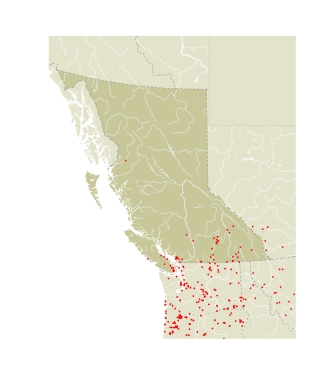West Coast Ladies are in flight from July to October, and again in the spring from March to June. It is unlikely that they successfully overwinter in BC as suggested by Treherne (1915), because of the lateness of the first recorded dates of appearance (late April). There is only a single brood, and the numbers of adults seen vary greatly from year to year. Eggs are laid from April to June, and develop into adults by late July. After the adults emerge in July and August, many, especially in the Southern Interior, fly up to subalpine and mountain meadows and join the throngs of Painted Ladies nectaring there. Males hilltop throughout the year, especially in late winter and spring in California. Males chase each other, other butterflies but especially other ladies, other large insects, and birds (Dimock 1973, 1978). The swarms of Painted Ladies, West Coast Ladies, and sometimes Red Admirals in the subalpine meadows become quite annoying when one is trying to spot other late summer butterflies.
Eggs are laid singly on the upperside of the leaves. The first instar larva makes a web shelter on the top of the leaf, and places its frass next to the webbing as camouflage. By the fourth instar, the leaf is rolled upward (sometimes downward) and tied together with silk. The fifth instar larva may wrap several leaves together in a nest. Pupation occurs within a folded leaf or leaves of the larval foodplant or other plants, or the pupa may be exposed on twigs or branches. Parasitism by tachinid flies is frequent, with maggots emerging from mature larvae or pupae (Dimock 1978).
The known larval foodplants in BC are stinging nettle and garden hollyhock (Dyar 1904b; Harvey 1908; Gibson 1915; Jones 1936; CSG). Outside BC larval foodplants include various Malvaceae, including Malva nicaeensis, M. parviflora, M. rotundifolia, Malvella leprosa, Sidalcea glaucescens, S. oregana, and Sphaeralcea ambigua (Dimock 1973,1978; Shapiro 1975b; Shapiro et al. 1981).
The separation of the North American Vanessa annabella as a distinct species from the South American V. carye is supported by protein differences shown through electrophoresis. The protein differences suggest that about 3 million years ago, when the Isthmus of Panama was formed, linking North and South America, V. carye colonized North America and then differentiated to form a new species, V. annabella. It is equally possible that the reverse pattern of colonization and differentiation occurred (Shapiro and Geiger 1989).
|
